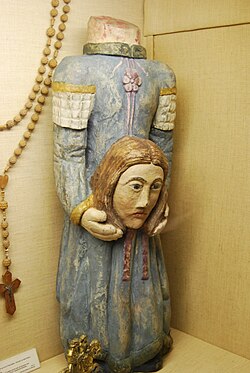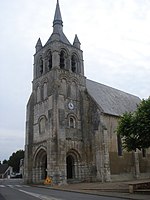
According to apocrypha, as well as Christian and Islamic tradition, Saint Anne was the mother of Mary, the wife of Joachim and the maternal grandmother of Jesus. Mary's mother is not named in the Bible's canonical gospels. In writing, Anne's name and that of her husband Joachim come only from New Testament apocrypha, of which the Gospel of James seems to be the earliest that mentions them. The mother of Mary is mentioned but not named in the Quran.

Denis of France was a 3rd-century Christian martyr and saint. According to his hagiographies, he was bishop of Paris in the third century and, together with his companions Rusticus and Eleutherius, was martyred for his faith by decapitation. Some accounts placed this during Domitian's persecution and incorrectly identified St Denis of Paris with the Areopagite who was converted by Paul the Apostle and who served as the first bishop of Athens. Assuming Denis's historicity, it is now considered more likely that he suffered under the persecution of the emperor Decius shortly after AD 250.

Lucia of Syracuse (283–304AD), also called Saint Lucia was a Roman Christian martyr who died during the Diocletianic Persecution. She is venerated as a saint in Catholic, Anglican, and Eastern Orthodox Christianity. She is one of eight women explicitly commemorated by Catholics in the Canon of the Mass. Her traditional feast day, known in Europe as Saint Lucy's Day, is observed by Western Christians on 13 December. Lucia of Syracuse was honored in the Middle Ages and remained a well-known saint in early modern England. She is one of the best known virgin martyrs, along with Agatha of Sicily, Agnes of Rome, Cecilia of Rome, and Catherine of Alexandria.

Odile of Alsace, also known as Odilia and Ottilia, born c. 662 - c. 720 at Mont Sainte-Odile), is a saint venerated in the Catholic Church and the Eastern Orthodox Church. She is a patroness saint of good eyesight and of the region of Alsace.

Saint Winifred was a Welsh virgin martyr of the 7th century. Her story was celebrated as early as the 8th century, but became popular in England in the 12th, when her hagiography was first written down.

Genevieve was a consecrated virgin, and is the patron saint of Paris in the Catholic and Orthodox traditions. Her feast day is on 3 January.

Saint Faith or Saint Faith of Conques is a saint who is said to have been a girl or young woman of Agen in Aquitaine. Her legend recounts how she was arrested during persecution of Christians by the Roman Empire and refused to make pagan sacrifices. Saint Faith was tortured to death with a red-hot brazier. Her death is sometimes said to have occurred in the year 287 or 290, sometimes in the large-scale Diocletianic Persecution beginning in 303. She is listed as "Sancta Fides, Virgin and martyr", in the martyrologies.
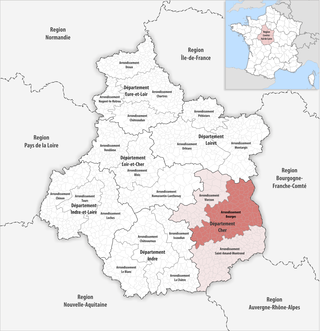
The arrondissement of Bourges is an arrondissement of France in the Cher department in the Centre-Val de Loire region. It has 128 communes. Its population is 173,037 (2016), and its area is 2,783.9 km2 (1,074.9 sq mi).
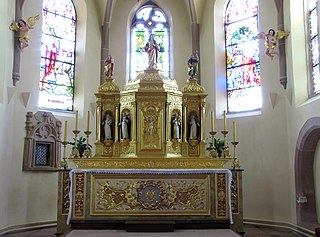
Columba of Sens, was a virgin and nun who was born to a noble pagan family in the northwest of the Iberian Peninsula. She left Gallaecia for Gaul as a child to avoid being denounced as a Christian and received the baptismal name Columba, meaning "dove" in French. She settled in Sens, France, where the Roman emperor Aurelian noticed her and tried to force her to marry his son. When she refused, he imprisoned her. She was protected from being burned alive by a female bear and a miraculous rain shower, but was finally beheaded. Columba was venerated throughout France; a chapel was later built over her relics and the Abbey of Sens, which at one time was a pilgrimage site in her honor, was eventually built there.

A cephalophore is a saint who is generally depicted carrying their severed head. In Christian art, this was usually meant to signify that the subject in question had been martyred by beheading. Depicting the requisite halo in this circumstance offers a unique challenge for the artist: some put the halo where the head used to be, and others have the saint carrying the halo along with the head. Associated legends often tell of the saint standing and carrying their head after the beheading.

Devota is the patron saint of Corsica and Monaco. She was killed during the persecutions of the Roman Emperors Diocletian and Maximian. She is sometimes identified with another Corsican saint named Julia, who was described in Latin as Deo devota. The description was misinterpreted as a proper name. The legend connected with her is similar to those told of other saints of the region, such as Reparata and Torpes of Pisa.
Saint Aurelia of Strasbourg was a 4th-century saint, whose tomb in Strasbourg became the centre of a popular cult in the Middle Ages.

Saint Honorina was a 3rd-century virgin martyr of Gallo-Roman northern France, venerated as a saint in the Catholic and Eastern Orthodox Churches. Believed to have been killed in the first years of the 4th century during the persecutions of Diocletian, very little is known of her life, apart from her reputed martyrdom for maintaining her Christian faith.
Saint-Doulchard is a commune in the Cher department in the Centre-Val de Loire region of France. It is on the outskirts of Bourges.
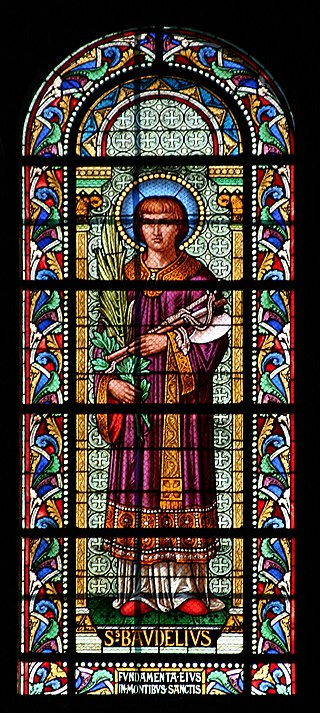
Saint Baudilus is venerated as a martyr by the Catholic Church. His cult is closely associated with the city of Nîmes but also spread into Spain.

Valerie of Limoges is a legendary Christian martyr and cephalophore, associated with the Roman period, whose cult was very important in Limousin, France, during the medieval period. She has been an important subject for Christian art since the Middle Ages and for porcelain figurines over several centuries.
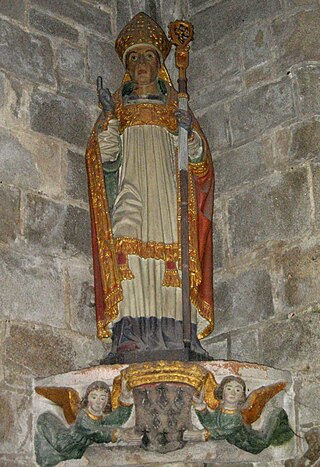
Saint Ronan was an Irish pilgrim saint and hermit in western Brittany. He was the eponymous founder of Locronan and co-patron of Quimper (France), together with its founder, Saint Corentin. He is also celebrated in the parish of Kilronan, Ireland

Saint Paraskevi of Rome is venerated as a Christian martyr of the 2nd century. She was arrested on multiple occasions for her Christianity and was eventually beheaded by the Roman governor Tarasius.
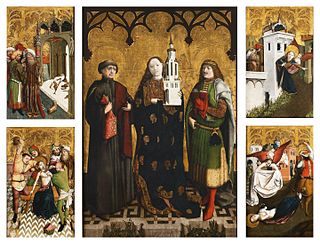
Saint Barbara, known in the Eastern Orthodox Church as the Great Martyr Barbara, was an early Christian Lebanese and Greek saint and martyr. Accounts place her in the 3rd century in Heliopolis Phoenicia, present-day Baalbek, Lebanon There is no reference to her in the authentic early Christian writings nor in the original recension of Saint Jerome's martyrology.

Saint Onenne is a local Breton saint whose cult exists only in Tréhorenteuc. The church of the municipality partly bears her name. Initially associated with the image of a "Celtic saint," her cult has been linked to symbols of the swan-maiden or the bird goddess close to the goddess Ana, hence her connection with ducks and geese, birds that have retained an important place in her hagiography. Although she is said to have lived in the 7th century, her first written mention dates back to the 11th century. Over time, the removal of original elements brings her cult closer to that of the Virgin Mary associated with grace and purity.
